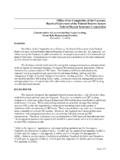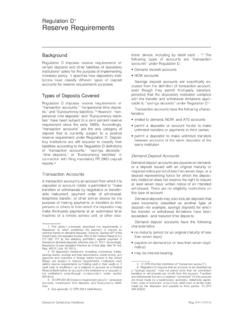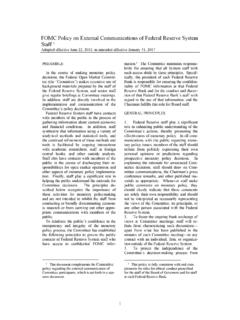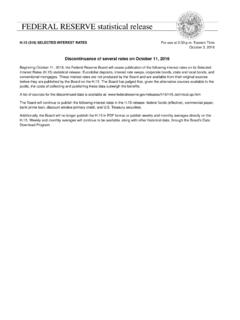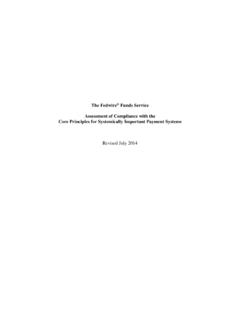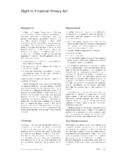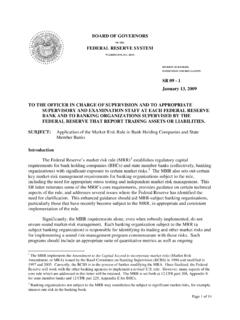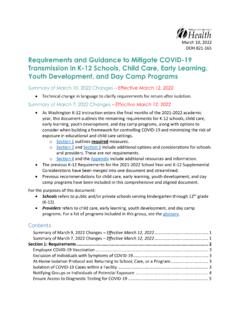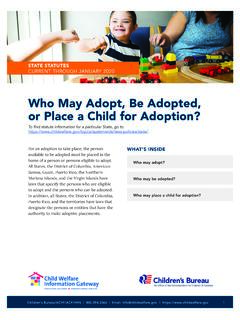Transcription of Dollar in the Age of Digital
1 RESEARCH & ANALYSISM oney and Payments: The in the Age of DigitalTransformationJanuary 2022 BOARD OF GOVERNORS OF THE FEDERAL RESERVE SYSTEMThe Federal Reserve System is the centralbank of the United States. It performs fivekey functions to promote the effectiveoperation of the economy and, moregenerally, the public Federal Reserve conducts the nation's monetary policyto promote maximum employmentand stable prices in the economy; promotes the stability of the financial systemand seeks to minimize andcontain systemic risks through active monitoring and engagement in and abroad; promotes the safety and soundness of individual financial institutionsand monitors their impact on the financial system as a whole; fosters payment and settlement system safety and efficiencythroughservices to the banking industry and government that transactions and payments.
2 And promotes consumer protection and community developmentthroughconsumer-focused supervision and examination, research and analysis ofemerging consumer issues and trends, community economic developmentactivities, and administration of consumer laws and learn more about us, visit Existing Forms of Payment Improvements to the Payment Challenges for the Payment Bank Digital and Functions of a Benefits of a Risks and Policy considerations for a Comment and Next Benefits, Risks, and Policy A: Federal Reserve Research on Digital and Policy Engagement and B: Types of Bank Bank C: Access to Money and Payment SummaryFor a nation s economy to function effectively, its citizens must have confidence in its money andpayment services.
3 The Federal Reserve, as the nation s central bank, works to maintain the pub-lic s confidence by fostering monetary stability, financial stability, and a safe and efficient pay-ment paper is the first step in a public discussion between the Federal Reserve and stakeholdersabout central bank Digital currencies (CBDCs). For the purpose of this paper, a CBDC is defined asa Digital liability of a central bank that is widely available to the general public. In this respect, it isanalogous to a Digital form of paper money. The paper has been designed to foster a broad andtransparent public dialogue about CBDCs in general, and about the potential benefits and risks ofa CBDC.
4 The paper is not intended to advance any specific policy outcome, nor is it intendedto signal that the Federal Reserve will make any imminent decisions about the appropriateness ofissuing a technologies offered by the Federal Reserve have evolved over time. In the FederalReserve s early years, it established a national check-clearing system and used dedicated tele-graph wires to transfer funds between banks. In the 1970s, the Federal Reserve developed anautomated clearinghouse (ACH) system that offered an electronic alternative to paper checks. Andin 2019, the Federal Reserve committed to building the FedNowSMService, which will provide real-time, around-the-clock interbank payments, every day of the technological advances have ushered in a wave of new private-sector financial productsand services, including Digital wallets, mobile payment apps, and new Digital assets such as cryp-tocurrencies and stablecoins.
5 These technological advances have also led central banks aroundthe globe to explore the potential benefits and risks of issuing a Reserve policymakers and staff have studied CBDC closely for several years, guided by anunderstanding that any CBDC should, among other things provide benefits to households, businesses, and the overall economy that exceed any costsand risks; yield such benefits more effectively than alternative methods; complement, rather than replace, current forms of money and methods for providing financialservices;1 protect consumer privacy; protect against criminal activity; and have broad support from key Federal Reserve is committed to soliciting and reviewing a wide range of views as it continuesto study whether a CBDC would be appropriate.
6 Irrespective of any ultimate conclusion, Fed-eral Reserve staff will continue to play an active role in developing international standardsfor TopicsThis paper begins with a discussion of existing forms of money; the current state of the pay-ment system and its relative strengths and challenges; and the various Digital assets that haveemerged in recent years, including stablecoins and other cryptocurrencies. The paper then turnsto CBDC, focusing on its uses and functions; potential benefits and risks; and related Federal Reserve s initial analysis suggests that a potential CBDC, if one were created,would best serve the needs of the United States by being privacy-protected, intermediated, widelytransferable, and identity-verified.
7 As noted above, however, the paper is not intended to advance aspecific policy outcome and takes no position on the ultimate desirability of a OutreachThe Federal Reserve will seek input from a wide range of stakeholders that might use a CBDC orbe affected by its introduction. This paper concludes with a request for public comment, the firststep in a broad consultation that will also include targeted outreach and public and Payments: The Dollar in the Age of Digital TransformationIntroductionThe Federal Reserve is exploring the implications of, and options for, issuing a CBDC. For the pur-pose of this paper, a CBDC is defined as a Digital liability of the Federal Reserve that is widelyavailable to the general public.
8 While Americans have long held money predominantly in digitalform for example in bank accounts recorded as computer entries on commercial bankledgers a CBDC would differ from existing Digital money available to the general public because aCBDC would be a liability of the Federal Reserve, not of a commercial CBDC could potentially offer a range of benefits. For example, it could provide households andbusinesses a convenient, electronic form of central bank money, with the safety and liquidity thatwould entail; give entrepreneurs a platform on which to create new financial products and ser-vices; support faster and cheaper payments (including cross-border payments); and expand con-sumer access to the financial system.
9 A CBDC could also pose certain risks and would raise avariety of important policy questions, including how it might affect financial-sector market struc-ture, the cost and availability of credit, the safety and stability of the financial system, and the effi-cacy of monetary introduction of a CBDC would represent a highly significant innovation in American , broad consultation with the general public and key stakeholders is essential. Thispaper is the first step in such a conversation. It describes the economic context for a CBDC, keypolicy considerations , and the potential risks and benefits of a CBDC. It also solicits feed-back from all interested Federal Reserve does not intend to proceed with issuance of a CBDC without clear supportfrom the executive branch and from Congress, ideally in the form of a specific authorizing the purpose of this paper, commercial bank includes all depository Existing Forms of MoneyMoney serves as a means of payment, a store of value, and a unit of account.
10 In the UnitedStates, money takes multiple forms:2 Central bank moneyis a liability of the central bank. In the United States, central bank moneycomes in the form of physical currency issued by the Federal Reserve and Digital balances heldby commercial banks at the Federal Reserve. Commercial bank money is the Digital form of money that is most commonly used by the bank money is held in accounts at commercial banks. Nonbank moneyis Digital money held as balances at nonbank financial service firms typically conduct balance transfers on their own books using a range of technolo-gies, including mobile different types of money carry different amounts of credit and liquidity risk.
